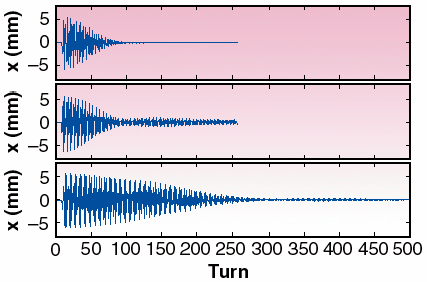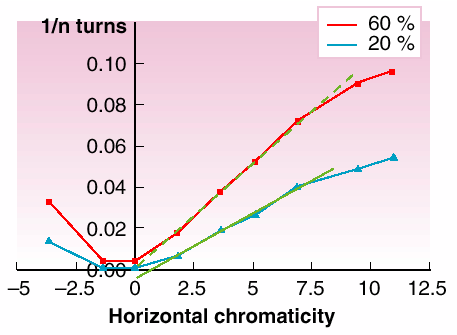- Home
- Users & Science
- Scientific Documentation
- ESRF Highlights
- ESRF Highlights 2000
- The X-ray Source
- Non-linear Optics Studies
Non-linear Optics Studies
The energy acceptance of the machine, which stands around ±3%, is mainly dictated by transverse aperture-related limitations. A good modelling of the non-linear behaviour of the optics is essential to improve the understanding of these limitations. Due to the small momentum compaction and the large sextupoles required to correct the chromaticity and enlarge the dynamic aperture, the linear description of the optics is inadequate when considering the large excursions in momentum experienced by Touschek scattered particles. Higher order terms are required to provide an accurate description of the change of the orbit path length, the dispersion, the momentum compaction and the chromaticity. Studies are being focused in two directions:
1. Measurements of lattice characteristics and detuning with amplitude using the turn-by-turn BPM system which allows the measurement of the beam position in both planes at each BPM station over a large number of turns. For this kind of study, the main limitation comes from the beam decoherence. Among the contributions to beam decoherence, the amplitude-dependent tune shifts play an important role as illustrated in Figure 126.
 |
Fig. 126: Horizontal centre of charge position as a function of turn after a horizontal kick, for three sets of sextupoles producing decreasing tune shifts with amplitude.
|
The contribution of the chromaticity to the decoherence also limits the range of possible measurements. The decoherence rate (defined as the inverse of the number of turns over which the betatron invariant remains larger than a given fraction of the initial invariant) is plotted in Figure 127 as a function of horizontal chromaticity.
 |
Fig. 127: Decoherence as a function of chromaticity for betatron oscillations larger than 20% and 60% of the initial invariant.
|
Measured tune shifts with amplitude are systematically larger than predicted. This could be due to either an imperfect sextupole calibration or to the contributions from errors in the real machine.
2. Variation of lattice characteristics with energy deviations. A very strong non-linear behaviour was observed on the negative energy side on closed orbit, tunes or synchrotron frequency. The preliminary comparison of experimental data with predictions from tracking simulations confirms that off-momentum tracking is not trivial. Investigations on the credibility of tracking methods are under way.



